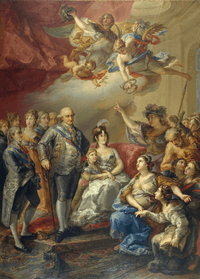Princess Maria Antonia of Naples and Sicily
| Maria Antonia of Naples and Sicily | |||||
|---|---|---|---|---|---|
| Princess of Asturias | |||||
 Maria Antonia of Naples, Princess of Asturias Portrait by Vicente López Portaña, c. 1805 | |||||
| Born |
14 December 1784 Caserta Palace, Caserta, Naples | ||||
| Died |
21 May 1806 (aged 21) Royal Palace of Aranjuez, Aranjuez, Spain | ||||
| Burial | El Escorial, Madrid | ||||
| Spouse | Ferdinand, Prince of Asturias | ||||
| |||||
| House | Bourbon-Two Sicilies | ||||
| Father | Ferdinand IV of Naples and III of Sicily | ||||
| Mother | Maria Carolina of Austria | ||||
| Religion | Roman Catholicism | ||||
Maria Antonia of Naples and Sicily (14 December 1784 – 21 May 1806), was the youngest daughter of Ferdinand, King of Naples and Sicily, and Maria Carolina of Austria. As the wife of the future Ferdinand VII of Spain, then heir apparent to the Spanish throne, she held the title of Princess of Asturias.
Biography
She was known as Maria Antonia and was born at the Caserta Palace in Caserta, Italy. Named after her mother's favorite sister, Queen Marie Antoinette of France, she was an intelligent girl, having by the age of seventeen learned several languages.
Marriage

In a series of dynastic alliances, Maria Antonia became engaged to Infante Ferdinand, Prince of Asturias (who later became King Ferdinand VII of Spain), while her eldest brother, Francis, became engaged to Infante Ferdinand's sister Infanta Maria Isabella of Spain. On 6 October 1802, Maria Antonia married Infante Ferdinand in Barcelona, Spain.

The princess failed to provide the expected heir to the throne: her two pregnancies, in 1804 and 1805, ended in miscarriages. Her mother, Maria Carolina, was highly anti-French after the execution of her sister and brother-in-law during the French Revolution. She was also strongly opposed to the military expansion of the French republic. As Spain became more easily dominated by Napoleon Bonaparte, there were rumours that Maria Carolina wanted her daughter to poison the Queen of Spain and Manuel Godoy, Spain's prime minister. However, as with most poison rumours of the period, it is unlikely to be true, not least because both women were devout Roman Catholics and secondly because the Spanish court's ties to France were in no way greater or lesser than most in Europe's after Bonaparte's early victories. Maria Antonia's mother-in-law, Queen Maria Luisa, disliked her daughter-in-law and she encouraged rumours of a Habsburg poisoning plot, even subjecting her books and clothes to scrutiny in order to discredit her daughter-in-law further. In spite of all of this campaign of character assassination, Maria Antonia managed to gain considerable influence over her husband and created an opposition party against Queen Maria Luisa and Godoy.
Death
She died of tuberculosis on 21 May 1806 at the Royal Palace of Aranjuez in Aranjuez, Spain. It was rumoured that Maria Antonia had been poisoned by Maria Luisa and Godoy, although again there is no actual evidence. However, Queen Maria Carolina, who was devastated, truly believed this. Maria Antonia's father, King Ferdinand, consolidated Naples and Sicily into the Kingdom of the Two Sicilies a decade after her death.
The Neapolitan princess was buried at El Escorial in Spain. Her husband was to marry three more times: -
- Infanta Maria Isabel of Portugal in Madrid on 29 September 1816; the couple had two children who both died young;
- Maria Josepha Amalia of Saxony on 20 October 1819, but bore him no children;
- Maria Antonia's niece (born a month before her death), Princess Maria Christina of Naples and Sicily (more often known as of the Two Sicilies) with whom Ferdinand had the future Isabella II of Spain.
Bibliography
- EPTON, Nina, The Spanish mousetrap: Napoleon and the Court of Spain (London: Macdonald, 1973).
- HILT, Douglas, The troubled trinity: Godoy and the Spanish monarchs (Tuscaloosa; London: University of Alabama Press, 1987).
Ancestry
Titles, styles, honours and arms

Titles and styles
- 14 December 1784 - 6 October 1802 Her Royal Highness Princess Maria Antonia of Naples and Sicily
- 6 October 1802 - 21 May 1806 Her Royal Highness The Princess of Asturias, Infanta of Spain etc.
Honours
.svg.png) 6 October 1802 - 21 May 1806 108th Dame of the Royal Order for Nobles Ladies of Queen Maria Luisa
6 October 1802 - 21 May 1806 108th Dame of the Royal Order for Nobles Ladies of Queen Maria Luisa
External links
![]() Media related to Princess Maria Antonia of Naples and Sicily at Wikimedia Commons
Media related to Princess Maria Antonia of Naples and Sicily at Wikimedia Commons
